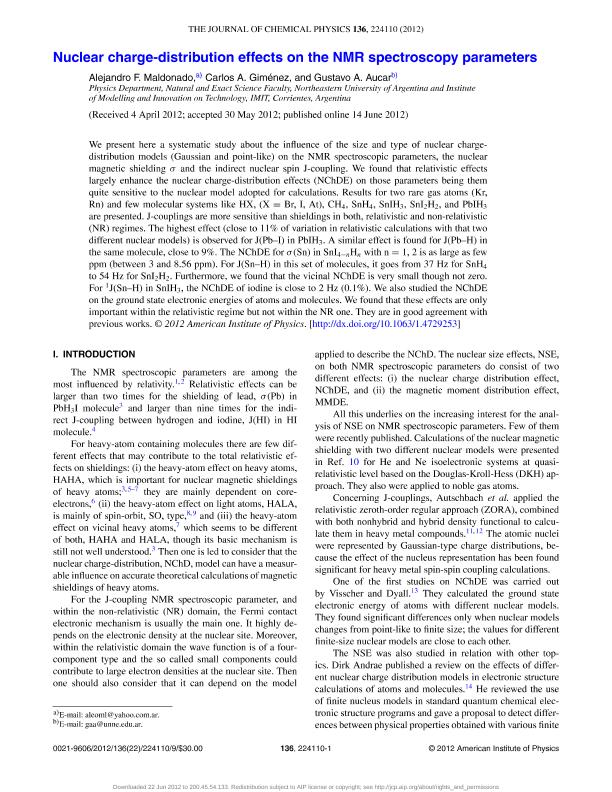Artículo
Nuclear charge-distribution effects on the NMR spectroscopy parameters
Fecha de publicación:
06/2012
Editorial:
American Institute of Physics
Revista:
Journal of Chemical Physics
ISSN:
0021-9606
Idioma:
Inglés
Tipo de recurso:
Artículo publicado
Clasificación temática:
Resumen
We present here a systematic study about the influence of the size and type of nuclear charge-distribution models (Gaussian and point-like) on the NMR spectroscopic parameters, the nuclear magnetic shielding σ and the indirect nuclear spin J-coupling. We found that relativistic effects largely enhance the nuclear charge-distribution effects (NChDE) on those parameters being them quite sensitive to the nuclear model adopted for calculations. Results for two rare gas atoms (Kr, Rn) and few molecular systems like HX, (X = Br, I, At), CH 4, SnH 4, SnIH 3, SnI 2H 2, and PbIH 3 are presented. J-couplings are more sensitive than shieldings in both, relativistic and non-relativistic (NR) regimes. The highest effect (close to 11 of variation in relativistic calculations with that two different nuclear models) is observed for J(Pb-I) in PbIH 3. A similar effect is found for J(Pb-H) in the same molecule, close to 9. The NChDE for σ(Sn) in SnI 4-nH n with n = 1, 2 is as large as few ppm (between 3 and 8.56 ppm). For J(Sn-H) in this set of molecules, it goes from 37 Hz for SnH 4 to 54 Hz for SnI 2H 2. Furthermore, we found that the vicinal NChDE is very small though not zero. For 1J(Sn-H) in SnIH 3, the NChDE of iodine is close to 2 Hz (0.1). We also studied the NChDE on the ground state electronic energies of atoms and molecules. We found that these effects are only important within the relativistic regime but not within the NR one. They are in good agreement with previous works.
Palabras clave:
Nmr
,
Nuclear Charge Distribution
,
Nse
Archivos asociados
Licencia
Identificadores
Colecciones
Articulos(IMIT)
Articulos de INST.DE MODELADO E INNOVACION TECNOLOGICA
Articulos de INST.DE MODELADO E INNOVACION TECNOLOGICA
Citación
Maldonado, Alejandro Fabián; Giménez, Carlos Ariel; Aucar, Gustavo Adolfo; Nuclear charge-distribution effects on the NMR spectroscopy parameters; American Institute of Physics; Journal of Chemical Physics; 136; 22; 6-2012; 224110-224120
Compartir
Altmétricas




